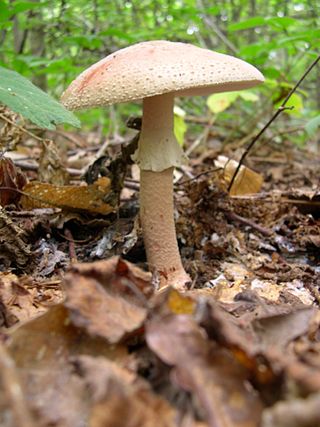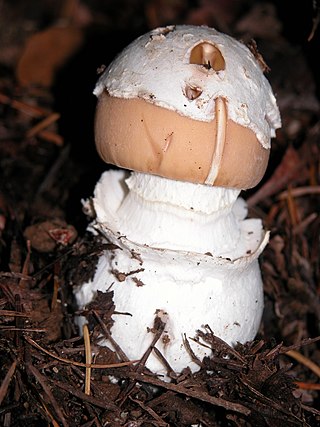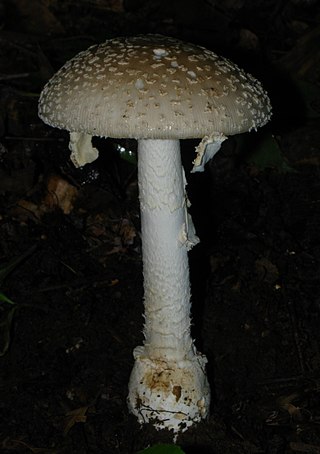
Amanita muscaria, commonly known as the fly agaric or fly amanita, is a basidiomycete of the genus Amanita. It is a large white-gilled, white-spotted, and usually red mushroom.

The genus Amanita contains about 600 species of agarics, including some of the most toxic known mushrooms found worldwide, as well as some well-regarded edible species. The genus is responsible for approximately 95% of fatalities resulting from mushroom poisoning, with the death cap accounting for about 50% on its own. The most potent toxin present in these mushrooms is α-Amanitin.

Amanita fulva, commonly called the tawny grisette or the orange-brown ringless amanita, is a basidiomycete mushroom of the genus Amanita. It is found frequently in deciduous and coniferous forests of Europe, and possibly North America.

Amanita porphyria, also known as the grey veiled amanita or the porphyry amanita, is a fairly common, inedible mushroom of the genus Amanita found in Europe and North America.

The blusher is the common name for several closely related species of the genus Amanita. A. rubescens, or the blushing amanita, is found in Europe and eastern North America, and A. novinupta, also known as the new bride blushing amanita, is found in western North America. Both their scientific and common names are derived from the propensity of their flesh to turn pink upon bruising or cutting.

Amanita citrina, commonly known as the false death cap or citron amanita, is a basidiomycotic mushroom, one of many in the genus Amanita. It grows in silicate soil in the summer and autumn months. It bears a pale yellow or sometimes white cap, with white stem, ring and volva. It is an inedible mushroom due to its toxicity, but is more pertinently often confused for the lethal death cap.

Amanita calyptroderma also known as coccora, coccoli or the Pacific amanita, is a white-spored mushroom that fruits naturally in the Sierra Nevada mountains and coastal forests of the western United States during the fall, winter and spring.

Amanita excelsa var. spissa is a variety of basidiomycete fungus of the genus Amanita. This large, grey to brown-capped fungus has a very variable appearance but is commonly encountered in coniferous and deciduous forests in Europe and North America. It is sometimes referred to by the common name grey spotted Amanita.

Amanita abrupta, commonly known as the American abrupt-bulbed amanita or the American abrupt-bulbed lepidella, is a possibly toxic species of fungus in the family Amanitaceae. Named for the characteristic shape of its fruit bodies, this white Amanita has a slender stem, a cap covered with conical white warts, and an "abruptly enlarged" swollen base. This terrestrial species grows in mixed woods in eastern North America and eastern Asia, where it is thought to exist in a mycorrhizal relationship with a variety of both coniferous and deciduous tree species.

Amanita daucipes is a species of fungus in the family Amanitaceae of the mushroom order Agaricales. Found exclusively in North America, the mushroom may be recognized in the field by the medium to large white caps with pale orange tints, and the dense covering of pale orange or reddish-brown powdery conical warts on the cap surface. The mushroom also has a characteristic large bulb at the base of its stem with a blunt short rooting base, whose shape is suggestive of the common names carrot-footed lepidella, carrot-foot amanita, or turnip-foot amanita. The mushroom has a strong odor that has been described variously as "sweet and nauseous", or compared to an old ham bone, or soap. Edibility is unknown for the species, but consumption is generally not recommended due its position in the Amanita subgroup Lepidella, which contains some poisonous members.

Amanita bisporigera is a deadly poisonous species of fungus in the family Amanitaceae. It is commonly known as the eastern destroying angel amanita, the eastern North American destroying angel or just as the destroying angel, although the fungus shares this latter name with three other lethal white Amanita species, A. ocreata, A. verna and A. virosa. The mushroom has a smooth white cap that can reach up to 10 centimetres across and a stipe up to 14 cm tall with a white skirt-like ring near the top. The bulbous stipe base is covered with a membranous sac-like volva. The white gills are free from attachment to the stalk and crowded closely together. As the species name suggests, A. bisporigera typically bears two spores on the basidia, although this characteristic is not immutable. A. bisporigera closely resembles a few other white amanitas, including the equally deadly A. virosa and A. verna.

Amanita strobiliformis is a species of mushroom. It is commonly referred to as warted amanita.

Amanita ravenelii, commonly known as the pinecone lepidella, is a species of fungus in the family Amanitaceae. The whitish fruit bodies are medium to large, with caps up to 17 centimetres wide, and stems up to 25 cm (10 in) long. The cap surface has large warts and the stem has a scaly, bulbous base. The mushrooms have a unique chlorine like odor.

Amanita volvata, also known as volvate amanita is an inedible white-coloured species of fungi from the family Amanitaceae found in the southeastern United States. Can be confused with Amanita ponderosa, but that species is from the Iberian peninsula. The species is amyloid and have saccate volva, and elliptic spores.

Amanita breckonii is a species of agaric fungus in the genus Amanita. It is known from California and Washington, where it associates with Monterey pine, ponderosa pine, and spruce. The species was described as new to science in 1982 by mycologists Harry Delbert Thiers and Joseph Ammirati. The holotype specimen was collected in 1966 on the campus of San Francisco State University by then graduate student Gary Breckon, for whom the species is named.

Amanita multisquamosa or the small funnel-veil amanita is a species of Amanita from the coniferous forest of eastern North America.

Amanita velatipes or veiled-bulb amanita is a species of Amanita from eastern North America.

Amanita mutabilis is a species of Amanita from eastern United States. Amanita mutabilis has pink tones on the cap and stem, and will turn pink when its flesh is cut; it smells of anise.

Amanita polypyramis is a species of Amanita found in the Eastern United States. It is a large, bone white mushroom with a chlorine-like odor. Its species name, polypyramis, refers to the pyramid-like warts on the surface of the pileus (cap).




















